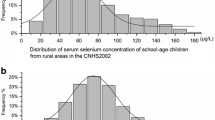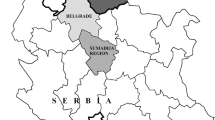Abstract
Blood serum selenium levels were measured in 891 healthy children and adolescents (aged 11–18 yr, 450 girls and 441 boys) residing in both rural and urban areas from eight regions of Slovakia. Subjects were divided into four age groups (11–12 y, 13–14 y, 15–16 y, and 17–18 y). Serum selenium concentration was determined by the electrothermal atomic absorption spectrometric method. The mean (±SD) serum selenium concentrations were 0.750 ±0.255 µmol/L in girls and 0.773 ±0.235 µmol/L in boys. A large proportion of the individuals (25.7% in girls, 18.1% in boys) exhibited serum selenium levels under 0.57 µmol/L (45 µg/L). An increasing trend of the serum selenium values with age has been observed in both boys (p < 0.01) and girls (p < 0.05). Boys had higher serum selenium levels in the all age groups but the differences were not statistically significant.
Similar content being viewed by others
References
B. A. Zachara, Mammalian selenoproteins,J. Trace Elements Electrolytes Health Dis. 6, 137–157 (1992).
J. T. Rotruck, A. L. Pope, H. E. Ganther, A. B. Swanson, D. G. Hafeman, and W. G. Hoekstra, Selenium: biochemical role as a component of glutathione peroxidase,Science 179, 588–590 (1973).
D. Behne, A. Kyriakopoulos, H. Meinhold, and J. Köhrle, Identification of type I iodothyronine 5’-deiodinase as a selenoenzyme,Biochem. Biophys. Res. Commun. 173, 1143–1149 (1990).
J. Köhrle, Thyroid hormone deiodinases—a selenoenzyme family acting as gate keepers to thyroid hormone action,Acta Med. Austriaca 23, 17–30 (1996).
L. Kiremidjian-Schumacher, M. Roy, H. I. Wishe, M. W. Cohen, and G. Stotzky, Supplementation with selenium and human immune cell functions. Effect on cytotoxic lymphocytes and natural killer cells,Biol. Trace Element Res. 41, 115–127 (1994).
G. N. Schrauzer, D. A. White, and C. J. Schneider, Cancer mortality correlation studies. III. Statistical associations with dietary selenium intakes,Bioinorg. them. 7, 23–34 (1977).
J. T. Salonen, G. Alfthan, J. K. Huttunen, J. Pikkarainen, and P. Puska, Association between cardiovascular death and myocardial infarction and serum selenium in a matched-pair longitudinal study,Lancet 2, 175–179 (1982).
W. C. Willet, J. S. Morris, S. Pressel, J. O. Taylor, B. F. Polk, M. J. Stampfer, et al., Prediagnostic serum selenium and risk of cancer,Lancet 2, 130–134 (1983).
J. T. Salonen, Selenium and human cancer,Ann. Clin. Res. 18, 18–21 (1986).
P. Knekt, A. Aromaa, J. Maatela, G. Alfthan, R. K. Aaran, and M. Hakama, Serum selenium and subsequent risk of cancer among Finnish men and women,J. Natl. Cancer Inst. 82, 864–868 (1990).
B. E. Jacobson and G. Lockitch, Direct determination of selenium in serum by graphite-furnace atomic absorption spectrometry with deuterium background correction and a reduced palladium modifier: age specific reference ranges,Clin. Chem. 34, 709–714 (1988).
J. Versieck, L. Vanballenberghe, and A. De Kesel, Certification of second-generation biological reference material (freeze-dried human serum) for trace element determinations,Anal. Chim. Acta 204, 63–75 (1988).
K. Schwarz, Essentially and metabolic function of selenium,Med. Clin. North Am. 60, 745–758 (1976).
A. Brtková, T. Magálová, K. Babinská, and A. Béderová, Serum selenium levels in Slovak population,Biol. Trace Element Res. 46, 163–171 (1994).
M. A. Cser, I. Szikalai-Lázslo, H. Menzel, and I. Lombeck, Selenium and glutathione peroxidase activity in Hungarian children,J. Trace Elements Med. Biol. 10, 167–173 (1996).
B. Tiran, A. Tiran, A. Petek, E. Rossipal, and O. Wawschinek, Selenium status of healthy children and adults in Styria (Austria). Investigation of a possible undersupply in the Styrian population.Trace Element Med. 9, 75–79 (1992).
M. Verlinden, L. Vansprundel, J. C. Van der Auwera, and J. W. Eylenbosch, The selenium status of Belgian population groups, I. Healthy adults.Biol. Trace Element Res. 5, 91–102 (1983).
M. Gebre-Medhin, U. Ewald, and T. Tuvemo, Serum selenium is related to lowdensity lipoprotein in healthy children but not in children with diabetes,Upsala J. Med. Sci. 93, 57–62 (1988).
A. M. Smith, M. P. McMurry, G. M. Chan, and O. Leonard, Phenylketonuria affects the selenium status of children, adolescents, and young adults,J. Trace Elements Exp. Med. 7, 39–45 (1994).
T. Suzuki, T. Hongo, T. Ohba, K. Kobayashi, H. Imai, H. Ishida, et al., The relation of dietary selenium to erythrocyte and plasma selenium concentrations in Japanese college women,Nutr. Res. 9, 839–848 (1989).
F. Hincal, N. Basaran, S. Yetgin, and O. Gökmen, Selenium status in Turkey II. Serum selenium concentration in healthy residents of different ages in Ankara,J. Trace Elements Electrolytes Health Dis. 8, 9–12 (1994).
I. Lombeck, K. Kasperek, H. D. Harbisch, L. E. Freinendegen, and K. Bremer, The selenium state of healthy children. I. Serum selenium concentrations at different ages; activity of glutathione peroxidase of erythrocytes at different ages; selenium content of food of infants,Eur. J. Pediat. 125, 81–88 (1977).
D. Beker, Z. Romic, H. Krsnjavi, and Z. Zima, A contribution to the world selenium map.Biol. Trace Element Res. 33, 43–49 (1992).
D. J. M. Malvy, J. Arnaud, B. Burtschy, M. J. Richard, A. Favier, O. Houot, et al., Reference values for serum zinc and selenium of French healthy children,Eur. J. Epidemiol. 9, 155–161 (1993).
W. C. Wang, A. L. Mäkelä, V. Nantö, and P. Mäkelä, Serum selenium levels in diabetic children. A follow up study during selenium-enriched agricultural fertilization in Finland.Biol. Trace Element Res. 47, 355–364 (1995).
A. Chakar, R. Mokni, P. Chappuis, J. L. Mahu, P. A. Walravens, F. Bleiberg-Daniel, et al., Selenium status of healthy immigrant Parisian pre-school children,Biol. Trace Element Res. 36, 25–33 (1993).
Author information
Authors and Affiliations
Rights and permissions
About this article
Cite this article
Brtková, A., Magálová, T., Béderová, A. et al. Serum selenium levels in healthy slovak children and adolescents. Biol Trace Elem Res 67, 49–54 (1999). https://doi.org/10.1007/BF02784274
Received:
Revised:
Accepted:
Issue Date:
DOI: https://doi.org/10.1007/BF02784274




